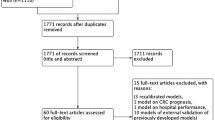Abstract
The decision-making process with regard to surgery in geriatric patients is of great importance, requiring consideration of ethical, medicolegal, and economic factors in addition to the purely medical ones. An important component in the decision-making process is the precise knowledge of the expected mortality. Clearly, such knowledge helps the surgeon as well as the patient and family to make the final decision whether to operate.
Twelve hundred major laparotomies in elderly patients were used as a data base. Thirty-six preoperative variants were noted for each patient as well as the occurrence of postoperative mortality or morbidity. All data were loaded into a 6,000 CDC computer and subjected to Multifactorial Stepwise Logistic Regression Analysis (MSLRA). The method allowed a choice of the 5 most significant factors in the prediction of mortality, as well as calculation of a numerical coefficient for every factor. A formula (MIX Formula) was devised to calculate the mortality in percentile terms using the factor coefficient. The results of this study show that the use of statistical multifactorial analysis permits an accurate preoperative prediction of postoperative mortality in geriatric candidates for major abdominal surgery. The accuracy of the prediction was confirmed by both retrospective and prospective analysis.
Résumé
La decisión d'entreprendre un traitement chirurgical chez le vieillard dépend non seulement de facteurs proprement médicaux mais aussi de considérations éthiques, médico-légales et économiques. Un facteur particulièrement important, dont dépend la décision, est la connaissance précise du taux éventuel de la mortalité. Sans aucun doute, elle aide le chirurgien, le malade et aussi la famille à prendre la décision la meilleure.
Mille deux cents malades âgés ont servi de base à cette étude. Trente six facteurs pré-opératoires chez chaque malade ont été retenus pour la conduire ainsi que la fréquence de la morbidité et de la mortalité post-opératoire. Tous ces éléments ont été soumis à l'analyse par ordinateur (système MSLRA). La méthode a permis un choix de 5 des facteurs les plus significatifs pour prédire la mortalité ainsi que le calcul d'un coefficient numérique pour chacun des facteurs. Une formule (formule MIX) a été imaginée pour calculer le pourcentage de mortalité en employant ce coefficient numérique. Les résultats de cette étude démontrent que l'emploi de l'analyse statistique multifactorielle permet de prédire avec précision le pourcentage de la mortalité chez le vieillard soumis à une intervention chirurgicale abdominale. Cette précision pré-opératoire du pronostic s'est avérée exacte à l'analyse rétrospective et prospective.
Resumen
El proceso de toma de decisiones en el paciente geriátrico es de importancia capital y requiere la consideración de factores éticos, médicolegales y económicos, además de aquellos puramente medicos. Un componente importante del proceso de toma de decisiones es el conocimiento exacto de la mortalidad anticipada. Es natural que tal conocimiento ayuda al cirujano, así como al paciente y su familia a tomar la decisión final.
Mil doscientas laparotomías mayores en pacientes de edad avanzada fueron usados como base de datos. Treinta y seis variantes preoperatorias fueron anotadas para cada paciente, así como la ocurrencia de mortalidad o morbilidad postoperatorias. Toda la información fue introducida a un computador 6,000 CDC y sometida a análisis multifactorial de regresión. El método hizo posible la escogencia de los 5 factores más significativos en la predicción de mortalidad, así como el cálculo de un coeficiente numérico para cada factor. Se diseñó una fórmula para calcular la mortalidad en términos porcentiles utilizando el factor coeficiente. Los resultados de este estudio demuestran que el uso del análisis estadístico mutlifactorial permite una predicción preoperatoria certera de la mortalidad postoperatoria en pacientes geriátricos candidatos a cirugía abdominal mayor. La precisión de la predicción fue confirmada tanto por el análisis retrospectivo como por el prospectivo.
Similar content being viewed by others
References
Marx, G.F., Matheo, C.V., Orkin, L.R.: Computer analysis of post-anesthetic deaths. Anesthesiology39:54, 1973
Wagner, D.P., Knaus, A., Draper, E.A.: Statistical validation of a severity-of-illness measure. Am J. Public Health73:878, 1983
Schneider, A.: Assessment of risk factors and surgical outcome. Surg. Clin. North Am.63:1113, 1983
Cioffi, W.G., Ashikaga, T., Gamelli, R.L.: Probability of surviving postoperative acute renal failure. Ann. Surg.200:205, 1984
Spiegelhalter, D.: Computer-aided decision-making in medicine. Br. Med. J.289:567, 1984
Stahlzren, L.H.: An analysis of factors with influence mortality following extensive abdominal operations upon geriatric patients. Surg. Gynecol. Obstet.113:283, 1961
Mohn, D.N.: Estimation of surgical risk in the elderly. J. Am. Geriatr. Soc.31:99, 1983
Feigal, D.W., Blaisdell, F.: The estimation of surgical risk. Med. Clin. North Am.63:1131, 1979
Reiss, R., Deutsch, A.A., Eliashiv, A.: Decision-making process in abdominal surgery in the geriatric patient. World J. Surg.7:522, 1983
Reiss, R., Hoffman, S., Deutsch, A.A.: Cholecystectomy in patients over 70. Mt. Sinai J. Med.49:71, 1982
Mithoefer, A., Mithoefer, J.C.: Studies in the aged: Surgical mortality. Arch. Surg.65:58, 1964
Del Guercio, L.R.M., Cohn, J.D.: Monitoring operative risk in the elderly. J.A.M.A.243:1350, 1980
Bozzetti, F., Bonfanti, R., Bufalino, R., Morabite, A.: Multifactorial analysis of prognostic factors after subtotal gastrectomy. Ital. J. Surg. Sci.15:121, 1985
Coomans, D., Broeckaert, L., Jonckheer, M., Massart, L.: Comparison of multivariate discrimination techniques for clinical data: Application to the thyroid functional state. Meth. Inform. Med.22:93, 1983
Trotter, M.C., Gretchen, A., Cloud, M.S., Davis, M., Sanford, S.P., Urist, M.M., Soong, S.-J., Halpern, N.B., Maddox, W.A., Balch, C.M.: Predicting the risk of abdominal disease in Hodgkin's lymphoma. Ann. Surg.201:465, 1985
Owens, W.D., Felts, J.A., Spitznagel, E.L., Jr.: ASA physical status classifications: A study of consistency of ratings. Anesthesiology49:239, 1978
Lewin, I., Lerner, A.G., Green, S.H., Del Guercio, L.R.M., Siegel, J.H.: Physical class and physiologic status in the prediction of operative mortality in the aged sick. Ann. Surg.174:217, 1971
Reiss, R., Haddad, M., Lilos, P., Puchs, C.: Prediction of operative mortality in biliary surgery by multifactorial stepwise logistic regression analysis. Ital. J. Surg. Sci.15:116, 1985
Author information
Authors and Affiliations
Rights and permissions
About this article
Cite this article
Reiss, R., Haddad, M., Deutsch, A. et al. Prognostic index: prediction of operative mortality in geriatric patients by use of stepwise logistic regression analysis. World J. Surg. 11, 248–251 (1987). https://doi.org/10.1007/BF01656409
Issue Date:
DOI: https://doi.org/10.1007/BF01656409




